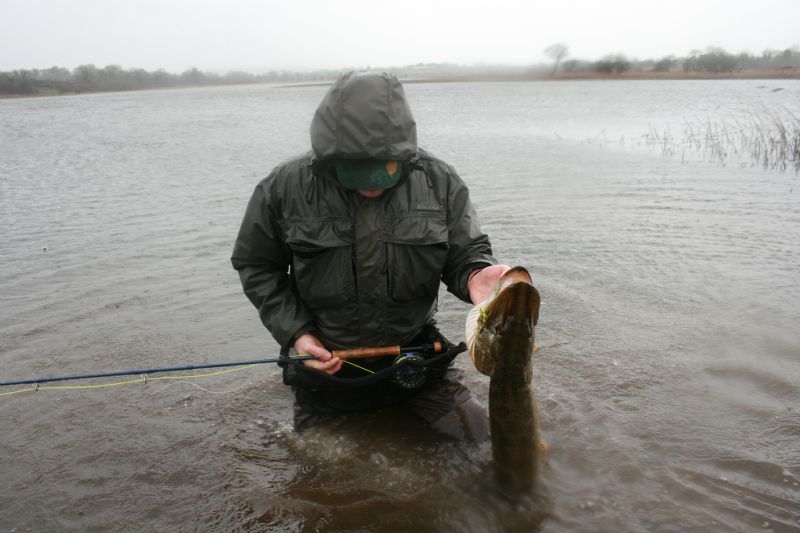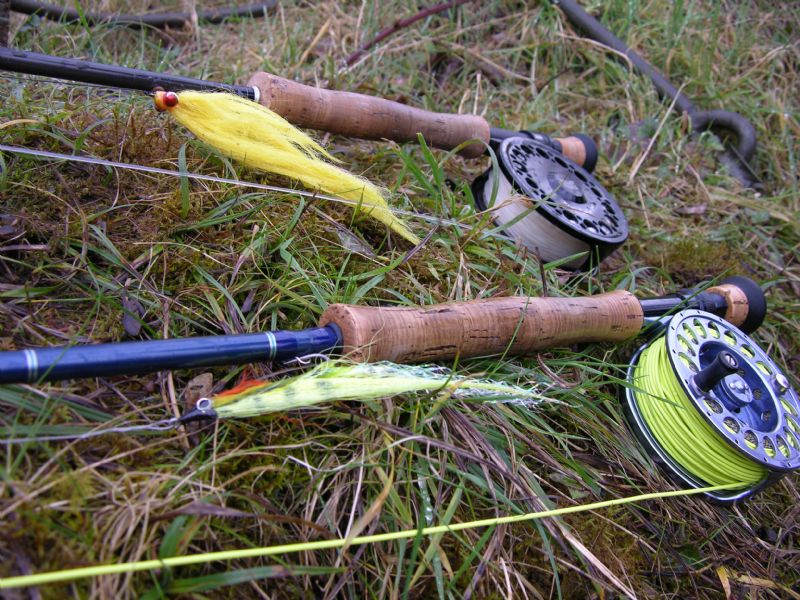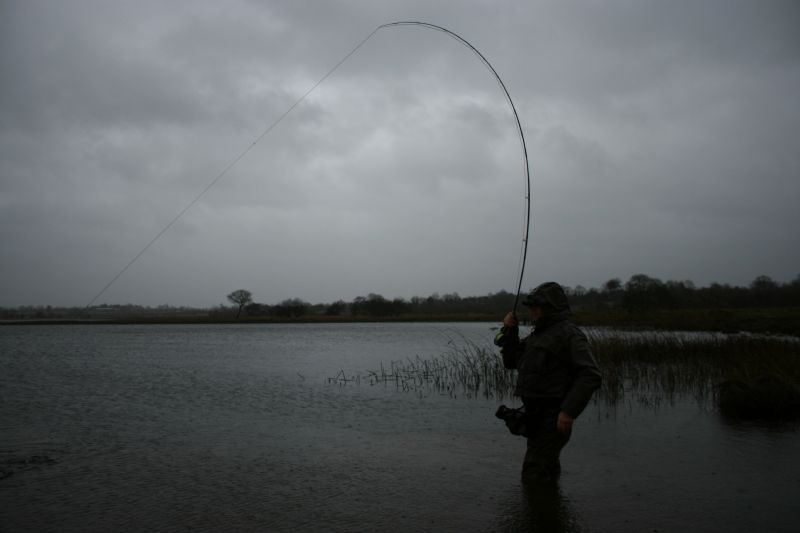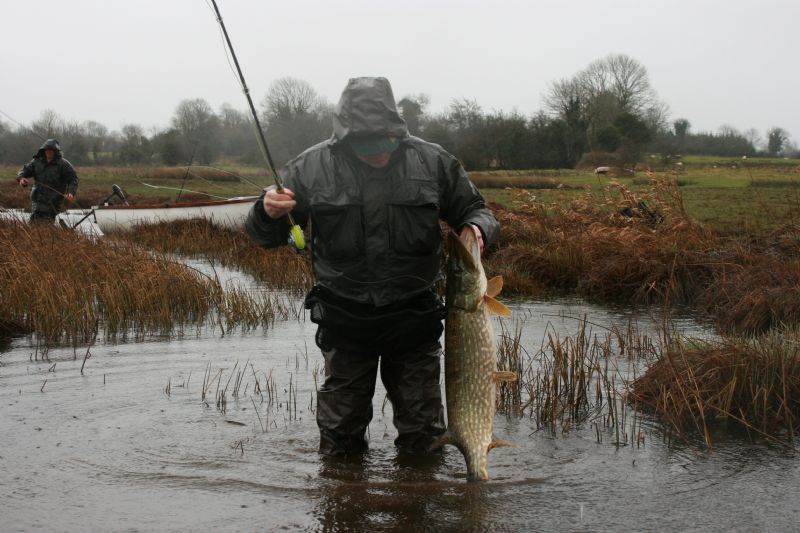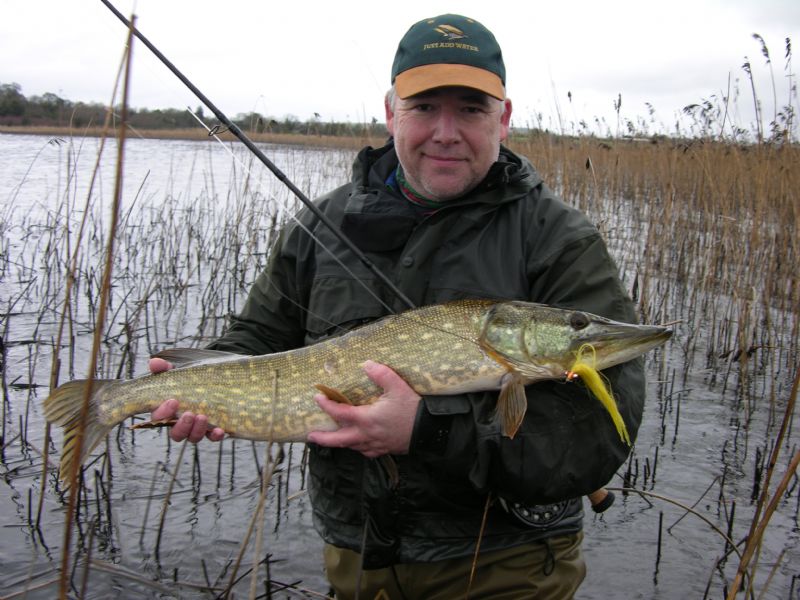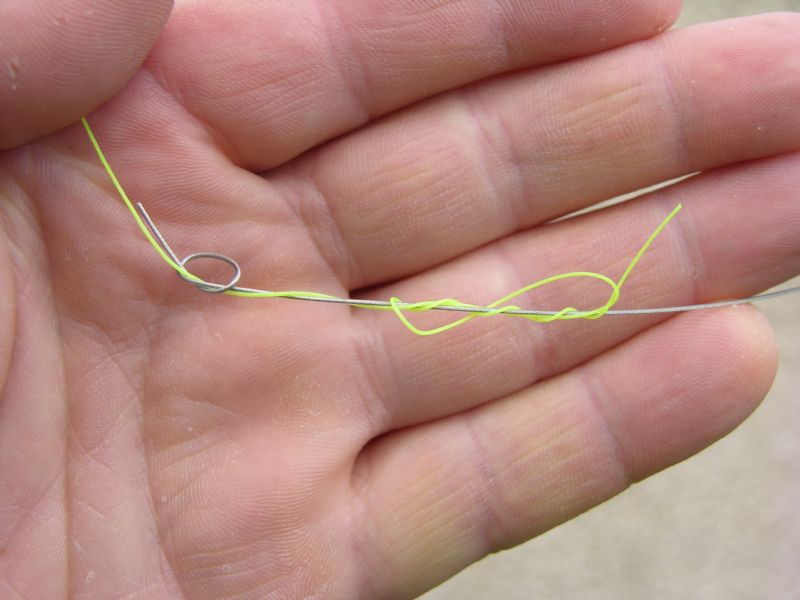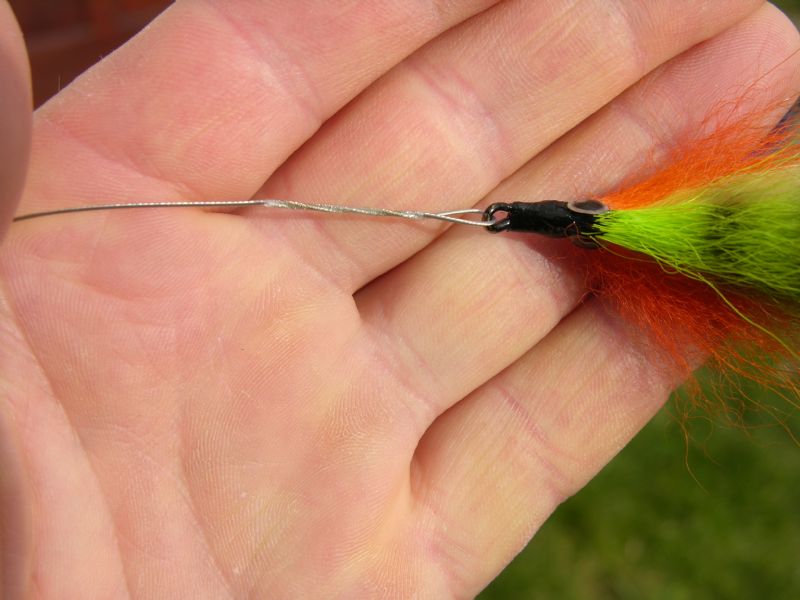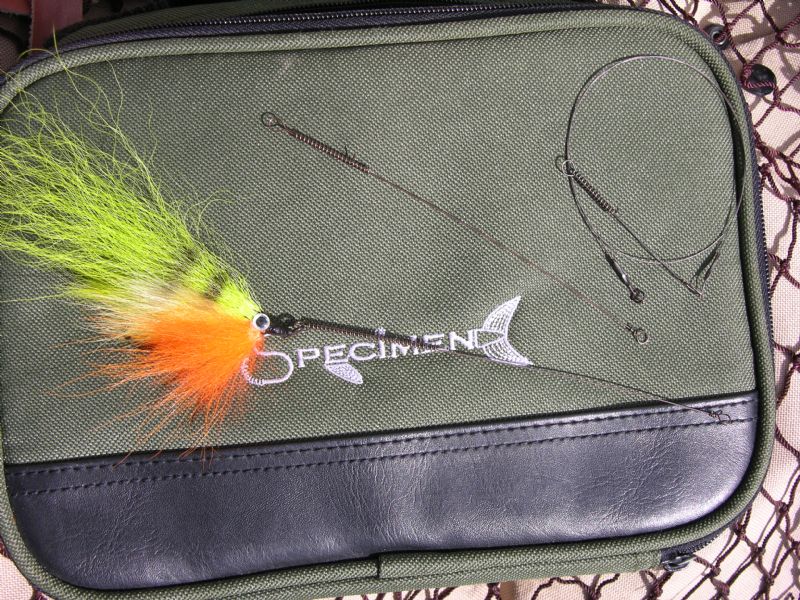Fly Fishing for Pike Part 1
Pike from the shore
When the editor of Irish Angler magazine asked me if would be prepared to put together an article on fly- fishing for Pike, of course I agreed.
Although this side of the sport is challenging and exciting in its own right, I felt the need to push the article a little further, and suggested that it may be interesting to target Pike on the fly from three different angles.
First approach could be from the shore, secondly, target them from a boat, and finally, have a try with the much talked about float tubes or “belly boats”. The belly boats in particular would be a new experience for me! Any cynical readers are probably saying that this is just an excuse to squeeze in as much angling as possible, and obviously, they would be quite right, it is!
So, for the purposes of this article, it was decided that part one of this three-part series would consist of a day solely from the shore. With this in mind, I had to get the thinking cap on and sort out a suitable venue that would lend itself to casting a fly from the water’s edge. Points to consider would be room for a back cast, safety to walk and wade in the shallows, and of course, the chance of a decent fish or two for the camera. Although Ireland was once considered a Pike angler’s paradise, productive and un-spoilt waters are unfortunately becoming increasingly difficult to find.
This is where Mark Corps comes in. Mark is not only knowledgeable on most aspects of angling in Ireland, but also a talented angler in his own right and a great guy to fish with. Mark suggested a meeting with Longford-based Kevin Lyons, angling guide and proprietor of the Melview Lodge B&B. After a couple of necessary phone calls, a day had been planned on one of his local isolated waters.
On meeting Kevin for the first time, his enthusiasm for angling was obvious. A guided tour around his excellent lodge revealed endless photographs of spectacular catches. Mark pointed out that showing me so many photographs of specimen fish was like opening a can of worms, and that he will be pestered by me from now on. He knows me only too well I’m afraid. With the niceties over, it was time to load up and head off, the adrenaline racing with thoughts of what may lie ahead. The back roads, twists and turns that led to the venue left me wishing I had brought a hand held gps with me as I had no chance of finding these waters again, should it be worth a further visit!
When travelling light, there is always that risk that you have forgotten something. Would jerk baits, spoons or plugs be more successful? How about dead baits? Such thoughts had to be put to rest. It was a fly adventure and we had to stick to the plan. Just as well, as it transpired, the hike to the waters edge would have been a nightmare, carrying the full compliment of tackle required for a day with dead baits!
The lake looked gorgeous, simply screaming out PIKE, but weather conditions were absolutely horrendous. We knew the forecast was for strong winds, showers and squalls, but hadn’t expected gales and constant driving rain. This made conditions uncomfortable and almost impossible to say the least, leaving only one section of shoreline fishable. I remember saying that this was definitely dead-bait weather, tucked up inside a bivvy or behind a well-pegged brolly! However, after the four-hour drive from home, there was no going back, and the fly rods were duly put together. Mark opted for an intermediate line and I chose the floating sink-tip as I intended staying close in, and around the shallow areas.
Struggling against the elements, I managed to tempt a decent fish
Working our way through the reeds, carefully feeling the depths, we were soon going through the motions, stealthily covering all fish holding features. Reeds jutting out into the water, and small inlets were all likely ambush areas for a wily predator. Casting was almost impossible against the wind, but a vicious haul on the back cast straightened the line suitably to allow a safe forward cast. On a positive note, false casts were un-necessary as the wind carried the line out an impressive distance on the forward stroke. Within a few casts, my fire-tiger perch imitation received a severe take; ripping several inches of line back through my cold, wet fingers. Unfortunately it hadn’t quite grasped the fly, or I was too slow to respond, and the fish was gone as quickly as it had arrived! A lost opportunity, but a roll cast placed the lure into the same area, with my heart beat in over-drive from the near miss encounter.
Safely "chinned" for a photograph before release
As is often the case with Pike, it immediately returned for another go and this time I was prepared. The line tightened and I lifted with controlled force and the hook was set. This was a good fish, as it simply shrugged its shoulders, in almost un-concerned fashion, and cruised off in the opposite direction! A minute or so of gentle persuasion had her calmed down and heading in my direction, where I guided her into the shallows for a photo session. There was no need for an un-hooking mat as she was held at all times above the water, but we did place her into a weigh sling where she tipped the scales at eighteen pounds. What a lovely start to the session, despite such awful conditions.
Carefully released once fully recovered, with Mark muttering curses under his breath, it was time for another cast, which produced a small fish of around four pounds. By now, we had covered most of the area in front of us. A move into the clearing several hundred yards to our right seemed like a good idea. The coffee break on route seemed like an even better idea as my hands were so cold, they had gone numb. Breathable chest waders are absolutely brilliant for comfort but do little to keep you warm in the middle of winter!
This new area looked just as “fishy” as the last, and with the weather deteriorating further it was Mark’s last chance to pluck out a decent fish. There were plenty of likely looking hot spots on the far side of the lake, but it would have been impossible to cast large flies against the continuing gale. Inching my way around to the right, and covering as much water as possible, I took another “pluck” on the fly but no fish. Ten minutes later, the same again. I put this down to the long tail on the fly and changed it for a similar, but shorter pattern, imagining that the Pike may be nipping the end or coming short.
Again, a severe take but no fish. This can be extremely frustrating to say the least. I asked Mark to join me, in an attempt to nail this fish one way or another, and took another look in the fly wallet for inspiration. Whilst deciding on a suitable creation, Mark covered the area for a few casts, and let out a yell that could be heard across the lake, despite the gale force winds. I looked up to see the aftermath of what could only be described as a crocodile, swirling at his feet, turning and disappearing into the murky water. Mark stood for several seconds, speechless; at what he later described as the largest freshwater fish he had ever seen, estimating it in the mid-thirty to forty pounds bracket! It had followed his fly right to the bank, only to roll on top of it, turn and swim off.
Needless to say, we thrashed the water relentlessly in a bid to tempt the big girl but we had missed our chance! Mark raised our hopes when he struck into a good fish that turned out to be a low teen. A fine fish by any standards, but she paled into insignificance I’m ashamed to say, after the image of the previous monster had been indelibly printed in our memories!
Not the monster we had seen, but a nice consolation prize
When we related this story back to Kevin, he merely smiled and suggested we fish one of his better lakes next time! Was he joking? Only time can tell, but hopefully it will be me telling the story, with glossy photographs to prove it. So what of my day fly-fishing from the shore? The weather conditions dampened our spirits somewhat, but this is Ireland, get used to it. The quality of the fish, fins and scale perfect, and in fighting fit condition far outweighed the miserable conditions. With good company and an excellent venue, I thoroughly enjoyed my experience, in no small way due to Mark and Kevin for sharing their expertise. We are sitting on a gold mine with such typical Irish waters, hopefully in the not-too-distant future, we will learn how to look after and protect them, at this moment in time we are failing I am sorry to say!
Tackle
Basic fly-fishing tackle for Pike is a nine feet, ten-twelve weight, fast-taper rod, coupled with a large arbour reel and suitable drag system. This weight of rod not only casts a large fly well, but is also necessary to subdue the antics of a powerful fish. Common choice of fly lines would be weight forward floating and intermediate, but some manufacturers produce special Pike lines with an exaggerated weight forward to aid casting. Make sure the reel is capable of holding one hundred yards of backing line. This is rarely called for as Pike, once hooked, will give short but powerful runs, but there may be that one occasion when a big girl will run that little bit further, and you will need that extra security. This tackle is readily available in almost all tackle shops now; such is the popularity of this ever-increasing side of the sport.
The leader can be attached to the fly line simply, with a braided loop; however, a needle knot or a nail knot is neater and helps the fly to turn over better on the final cast. A long leader is not required, and one of four to six feet is sufficient. Keeping it short and of thirty-forty pounds breaking strain will also aid fly turn over. I have used fifty pounds b/s on many occasions with no apparent reduction in “takes”. All Pike fly-fishing should incorporate a twenty-thirty lbs b/s wire biting trace.
Grinner knot or shock-leader knot
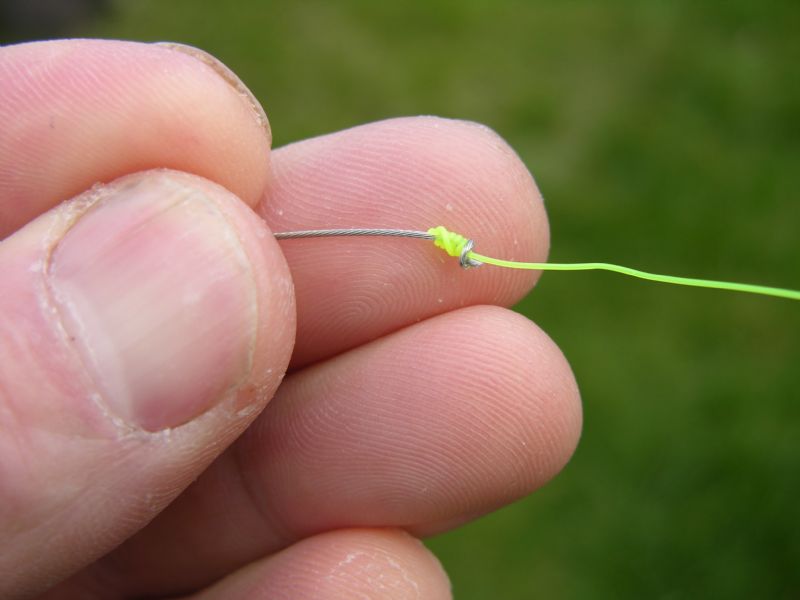
Showed using heavier diameter line and wire for the photograph
I attach my wire trace to the leader using a shock leader knot, popular when salt water beach casting. This is basically an overhand knot on the wire, combined with a grinner knot on the nylon leader. To date, this has never let me down. The wire is plastic coated multi strand, and I attach the fly by twisting the wire and fusing the plastic with a cigarette lighter.
Twisted and "fused" with the heat from a cigarette lighter
Another method of fly attachment, used by Ad Swier
Mark uses a Kevlar based wire that is supple enough to be knotted. There are so many versions on the market now, my advice would be to try a few and stick with one that you are confident with. Tying pike flies or lures is great fun. There are no real patterns to adhere to. Sparsely dressed or out and out budgies, it does not matter, however, the sparsely dressed flies are a heck of a lot easier to cast! This is something for the beginner to think about, before trying the really large lures.
If your fly looks like a naturally wounded, dying fish, or one that is desperately trying to escape, chances are a Pike will have a go at it. Most are tied with buck tail or rabbit fur giving added movement, incorporating holographic or silver synthetic products and man made fibres. Poppers are surface lures and are designed to create a top water disturbance, something like a wounded fish, frog or water vole. There are plenty of lures on the market but have a go at tying some yourself, as catching a Pike on a homemade creation can be a very satisfying part of the whole package. Consider hook sizes from 1/0 to 4/0 in strong Aberdeen patterns. Adding a weed guard can be helpful in some situations.
This discipline of angling covers large areas and necessitates scaling down the amount of tackle carried. A fine mesh net is useful, along with a weigh sling and scales if you wish to record the catch. An un-hooking mat is normally essential, but cumbersome to carry when continually on the move. If this is left behind, un-hook all fish over the water. A line tray is a godsend, keeping coils of line away from reeds and bushes. Carry all the usual un-hooking equipment such as forceps and side cutters should the hook become difficult to extract; however, after 250 plus pike on the fly, I have yet to require the use of side cutters.
Hold a Pike under the chin, avoiding the gill rakers, and it will usually oblige by opening its mouth and this will aid un-hooking. Remember at all times, a quickly landed and un-hooked fish will have a far greater survival rate than one that is detained out of water. Do not be embarrassed to ask for help to safely un-hook a fish if required until experience is gained. The emphasis is on fish health.
Although I do not have glasses on in the photographs, I strongly advise the use of eye protection and a suitable hat whilst casting. The weather on the day was so bad; I could not see through my sunglasses and had to remove them!




